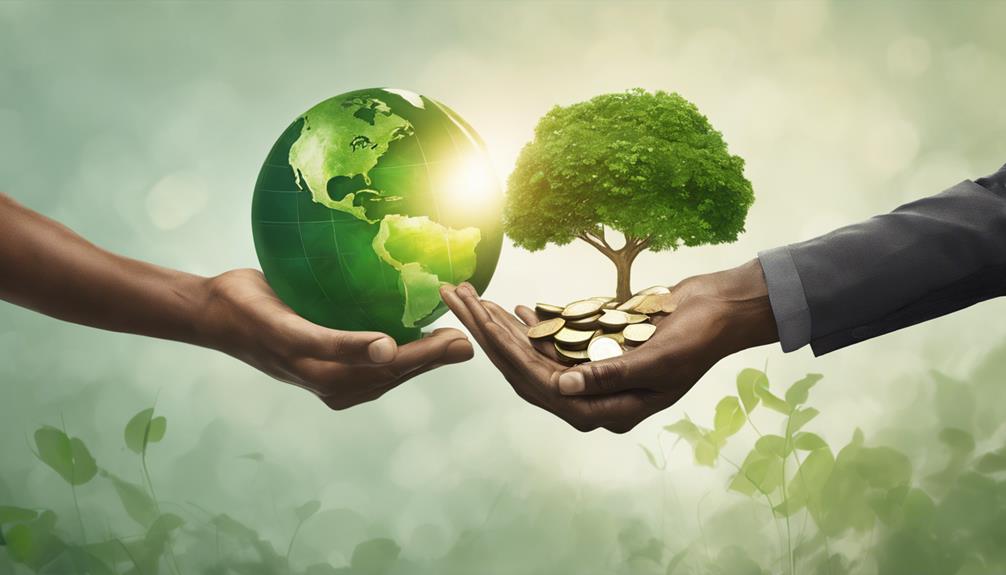Invest in green finance to secure a sustainable future. It supports eco-friendly projects and aligns with sustainability goals. Green bonds and other financial tools drive environmental-friendly initiatives while presenting attractive investment opportunities. Joining this sector not only benefits the environment but also yields promising returns for investors.
Key Takeaways
- Green finance offers sustainable investment opportunities for eco-friendly projects.
- It aligns financial goals with environmental initiatives through ESG criteria.
- Investing in green bonds supports sustainable development and social responsibility.
- Green finance integrates positive environmental and social impacts globally.
- Partnerships drive green financing initiatives for a sustainable financial ecosystem.
Green Finance Overview

In the field of finance, embracing green initiatives has become imperative for fostering sustainability and driving returns for investors. Green finance, a sector focused on environmentally-friendly projects, plays a pivotal role in promoting sustainable development while offering attractive investment opportunities.
This type of finance encompasses a range of financial tools like green bonds, loans, mortgages, and credit cards tailored specifically for eco-friendly initiatives.
Types and Benefits of Green Finance

You'll discover the essential components of green finance and the numerous benefits it brings to sustainable investing.
Green finance encompasses various financial instruments that support eco-friendly projects and initiatives.
Understanding these types and advantages will empower you to make informed decisions for a greener, more sustainable future.
Green Finance Essentials
With a focus on sustainability and environmental impact, green finance offers various types of financial instruments and brings numerous benefits to both investors and the planet.
Green finance, also known as sustainable finance, includes green mortgages, loans, credit cards, bonds, and asset-backed securities aimed at funding eco-friendly projects.
One primary instrument in green finance is green bonds, contributing to the global sustainable finance market valued at $4.2 trillion in 2022.
Green finance integrates Environmental, Social, and Governance (ESG) criteria, aligning financial objectives with environmental and social goals to address climate change and promote sustainability.
By considering these factors, green finance not only supports the shift to a low-carbon economy but also aids in advancing sustainable initiatives, promoting social responsibility, generating financial returns, and fostering the development of green infrastructure and technology.
As the sector grows, sustainable finance education becomes increasingly important to equip individuals for careers in socially responsible investing within the expanding green finance industry.
Sustainable Investment Benefits
Embracing sustainable investment brings forth a multitude of advantages, encompassing diverse types of green finance instruments and their associated benefits. Green financing options such as green mortgages, loans, credit cards, bonds, and asset-backed securities play an essential role in supporting eco-friendly projects aimed at reducing the environmental impact. Investing in sustainable investment funds not only advances environmental initiatives but also promotes social responsibility while generating financial returns. This proactive approach in the finance sector contributes to the development of green infrastructure and technology, fostering a more sustainable future for all.
The sustainable finance market has seen significant growth, with a global valuation of $4.2 trillion in 2022 and an expected annual growth rate of 22.4% by 2032. Countries like the U.S., China, and France are leading the way in issuing green bonds, reflecting a collective push towards sustainability efforts.
Sustainable finance, guided by Environmental, Social, and Governance (ESG) considerations, aims to drive economic growth, improve social outcomes, and preserve the environment through investments in green projects.
Sustainable Finance and Ethical Investing

Investors increasingly prioritize sustainable finance and ethical investing to align their financial portfolios with their values and contribute to a more environmentally and socially responsible future.
The sustainable finance market, valued at $4.2 trillion globally in 2022, is expected to grow annually by 22.4% by 2032. Countries like the U.S., China, and France are leading issuers of green bonds, reflecting a worldwide commitment to sustainability.
Green bonds present significant investment opportunities for promoting environmental projects and green initiatives within the financial sector. Sustainable finance integrates environmental, social, and governance (ESG) factors to foster economic growth and positive social outcomes.
ESG Criteria and Importance in Finance

The integration of ESG criteria in finance highlights the essential role of sustainability in guiding investment decisions towards positive environmental and social impacts. Sustainable finance incorporates ESG factors to promote economic growth, social well-being, and environmental protection in investment decisions.
By evaluating companies' impact on the environment, society, and governance practices, ESG criteria drive responsible investment practices that align financial goals with environmental and social objectives. ESG investing considers environmental limits, social justice initiatives, and diverse governance structures to foster positive change within the financial sector.
Moreover, sustainable finance emphasizes the importance of incorporating sustainable practices into investment portfolios. ESG stocks have shown outperformance compared to industry peers, indicating the financial benefits of integrating ESG criteria into investment strategies.
Hence, by prioritizing ESG criteria in finance, individuals and institutions can contribute to a more sustainable future while also potentially enhancing financial returns.
Challenges and Future of Sustainable Finance

Facing various hurdles and opportunities, sustainable finance navigates a dynamic landscape towards a greener future. Regulatory frameworks play a vital role in shaping the direction of green investments and ensuring that funds are channeled into environmentally and socially beneficial projects. Establishing consistent codes of conduct can help mitigate market volatility, fostering a stable environment for sustainable investment practices. Evaluating and avoiding greenwashing practices is essential to uphold the integrity of environmental and social initiatives funded through sustainable finance. Moreover, the future of sustainable finance hinges on the development of standardized criteria, reliable data, and enhanced reporting mechanisms. This will not only provide transparency but also drive the industry towards more impactful investments in social projects and environmental sustainability. As challenges persist in the lack of standardization and data reliability, innovative professionals have the opportunity to pioneer solutions that advance the field of sustainable finance.
| Challenges in Sustainable Finance | Solutions and Opportunities | Importance |
|---|---|---|
| Lack of standardization | Establishing consistent codes of conduct | Ensuring integrity of investments |
| Data unreliability | Developing standardized criteria and reliable data | Driving transparency and impact |
| Market volatility | Strengthening regulatory frameworks | Fostering stability in green investments |
Green Financing

Embracing eco-friendly funding means actively participating in the shift towards a sustainable, low-carbon economy. This type of financing focuses on investing in environmentally conscious projects within the renewable energy sector.
By allocating funds to initiatives that have a positive impact on the environment and society, green financing plays a pivotal role in addressing climate change and promoting sustainable development. The finance industry is increasingly recognizing the significance of aligning financial goals with environmental and social objectives, driving the growth of green financing.
Through green financing, individuals and organizations can contribute to the transformation towards a more sustainable future by supporting projects that prioritize sustainability and reduce carbon emissions. Investing in green projects not only benefits the planet but also presents financial opportunities that are aligned with long-term sustainability goals.
Alignment With Sustainable Development Goals (Sdgs)

Aligning with Sustainable Development Goals (SDGs) involves integrating green financing practices to drive positive environmental and social impact globally. Financial systems have a critical role in shaping future ecosystems and consumption patterns for sustainable development. UN Environment works towards aligning financial systems with the 2030 sustainable development agenda to promote green financing and support the public sector in creating an enabling environment for green investments to achieve SDGs. Public-private partnerships, facilitated through the issuance of green bonds, are crucial in driving sustainable development initiatives. Moreover, capacity building for community enterprises on micro-credit further supports the implementation of sustainable development goals through green financing.
| Key Points |
|---|
| UN aligns financial systems with 2030 sustainable development agenda |
| Financial markets influence future ecosystems and consumption patterns |
| Public-private partnerships through green bonds drive sustainable development |
| Capacity building for community enterprises supports SDGs implementation |
Resource Efficiency Programme

To advance sustainable finance and drive policy improvements, the Resource Efficiency Programme focuses on reviewing financing systems' policy and regulatory environments. It aims to develop sustainable finance roadmaps that guide investment decisions, ensuring a more important use of resources.
Additionally, the programme plays a pivotal role in assisting central banks and regulators in enhancing domestic financial market frameworks to support sustainable finance initiatives. By supporting multi-country policy initiatives at various levels, the Resource Efficiency Programme promotes sustainable finance and connects with green economy initiatives to inspire policy action for resource efficiency.
Through these efforts, the programme contributes to creating a more sustainable financial ecosystem that prioritizes resource efficiency and aligns investment decisions with the principles of a green economy.
Partnerships

Effective collaborations with stakeholders in the financial sector are essential for driving forward green financing initiatives. Collaborating with banks, investors, and the public sector is vital for promoting sustainable finance and reducing carbon emissions.
These multi-stakeholder partnerships not only amplify the impact of green financing but also catalyze policy actions that inspire public and private investors to prioritize environmental sustainability.
Public-private partnerships, particularly through the issuance of green bonds, play a significant role in advancing sustainable development goals by channeling investments into environmentally friendly projects.
Encouraging partnerships at various levels, from local to global scales, further strengthens the social and environmental impacts of green financing efforts.
Frequently Asked Questions
Is Green Finance Part of Sustainable Finance?
Yes, green finance is indeed part of sustainable finance. It drives capital towards environmentally-friendly initiatives, aligning financial goals with positive environmental impacts. By integrating sustainability into financial decisions, green finance supports a more sustainable future.
What Is Greening Finance a Roadmap to Sustainable?
Greening finance is a roadmap to sustainable practices. It guides you in aligning financial activities with eco-friendly goals, channeling investments responsibly, and supporting a low-carbon economy. By integrating green principles, you contribute to a more sustainable future.
What Is the Future of Sustainable Finance?
Embrace the future of sustainable finance – a dynamic landscape fueled by ESG principles, innovative products, and growing demand. Seize opportunities in this transformative field, where education and adaptability are keys to success.
What Is the Difference Between ESG Investing and Sustainable Investing?
ESG investing focuses on specific criteria like carbon emissions and board diversity in investments. Sustainable investing takes a broader view, considering long-term sustainability goals and positive environmental and social impacts alongside financial returns.
Conclusion
To sum up, green finance is paving the way towards a sustainable future. Did you know that investments in renewable energy reached a record high of $282.2 billion in 2020, according to the United Nations?
By choosing green finance options, you can't only contribute to a greener planet but also potentially grow your portfolio while making a positive impact on the world. There are a variety of ecofriendly investment options available, including renewable energy projects, sustainable agriculture, and green technology companies. These investments not only have the potential for financial growth, but also promote environmental sustainability and social responsibility. By incorporating green finance into your investment strategy, you can align your financial goals with your values and make a meaningful difference in the world.
So why wait? Start investing in a sustainable future today!









